Attached files
| file | filename |
|---|---|
| 8-K - FORM 8-K - LIGHTBRIDGE Corp | form8k.htm |
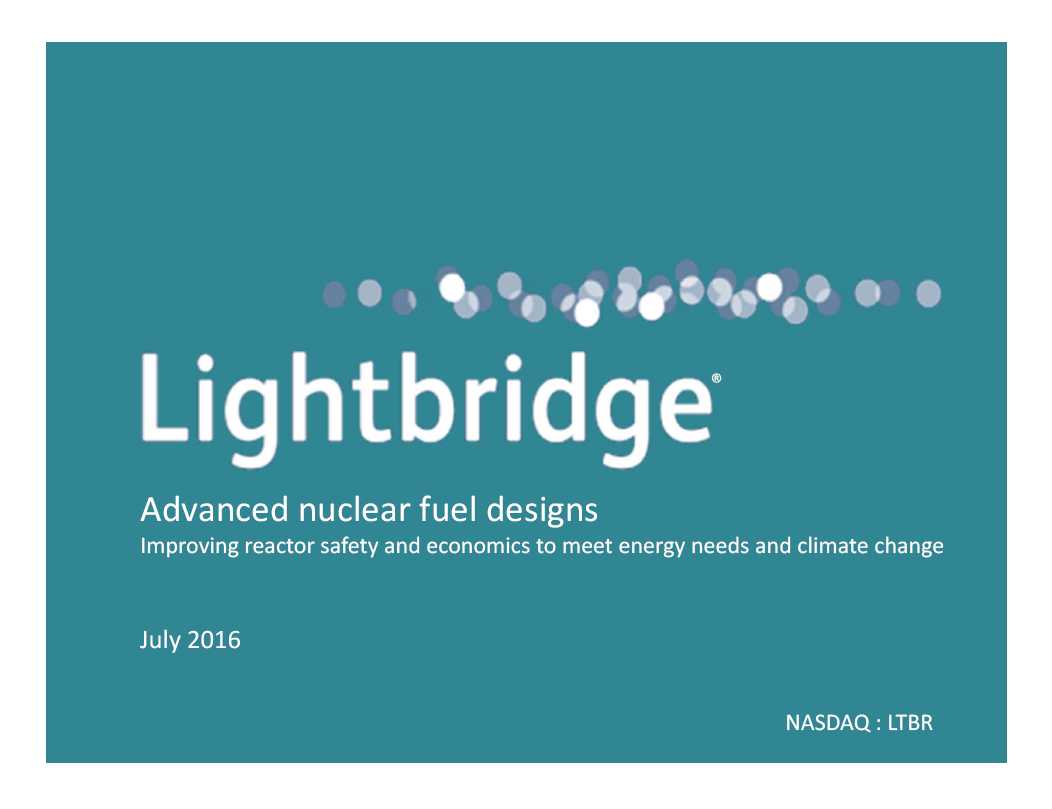
Safe Harbor Statement
With the exception of historical matters, the matters discussed in this presentation are forward -looking statements within the meaning of the Private Securities Litigation Reform Act of 1995, including statements regarding the Company’s competitive position, the timing of demonstration testing and commercial production, future demand for nuclear energy, the Company’s product and service offerings, and the expected market for and revenue from the Company’s product and service offerings.
These statements are based on current expectations on the date of this presentation and involve a number of risks and uncertainties that may cause actual results to differ significantly from such estimates. The risks include, but are not limited to, the degree of market adoption of the Company’s product and service offerings; market competition; dependence on strategic partners; demand for fuel for nuclear reactors; and the Company’s ability to manage its business effectively in a rapidly evolving market, as well as other factors described in Lightbridge’s filings with the Securities and Exchange Commission.
Lightbridge does not assume any obligation to update or revise any such forward -looking statements, whether as the result of new developments or otherwise. Readers are cautioned not to put undue reliance on forward -looking statements.
2


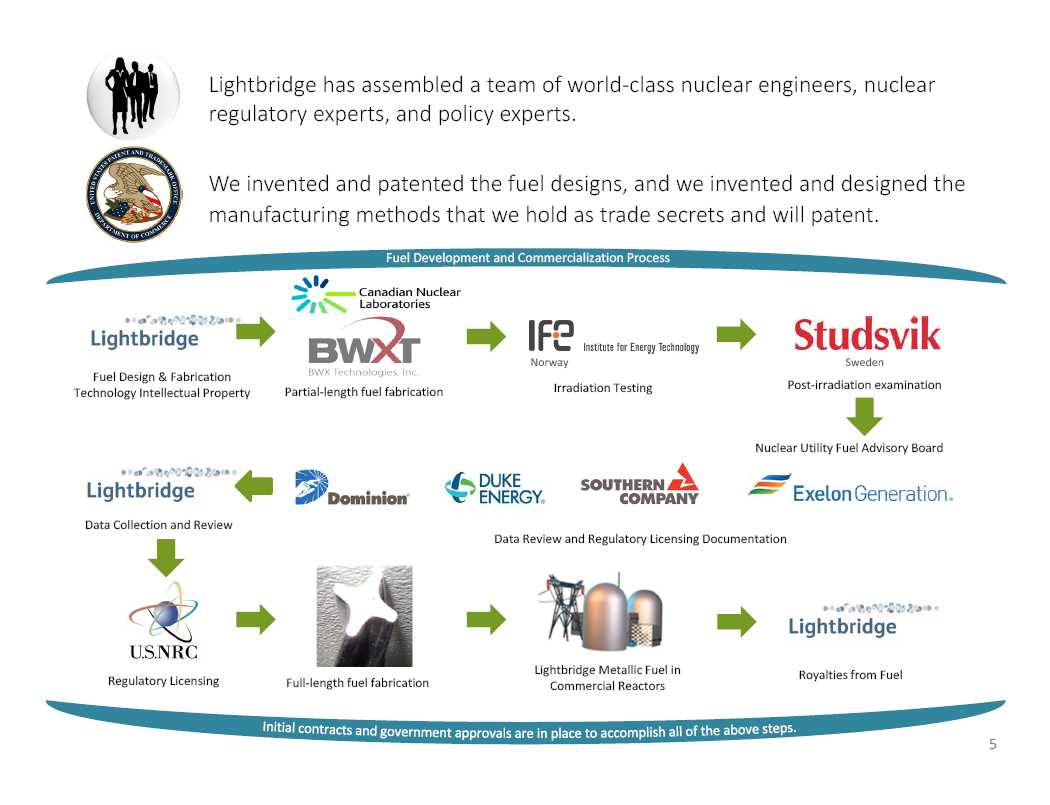



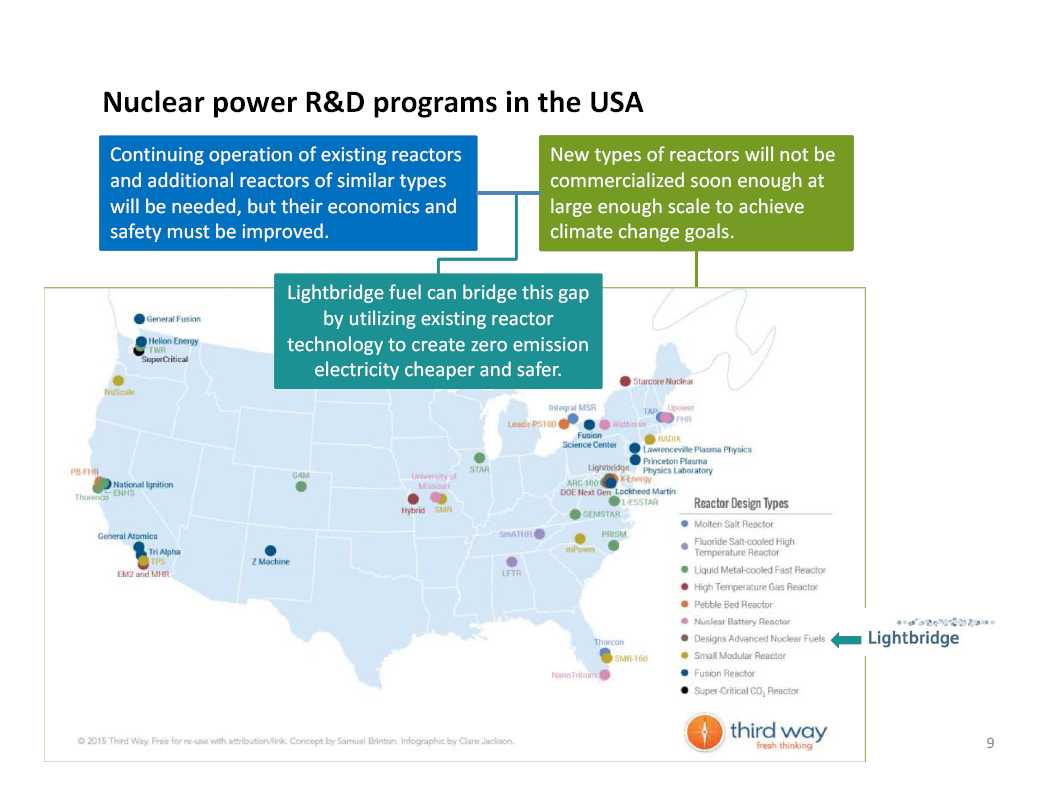



What happens when there is a loss of coolant accident (LOCA) 1
The graphs show the peak cladding temperature (PCT) at several points along the length of the fuel during the accident for both conventional uranium dioxide fuel and Lightbridge -designed metallic fuel operating at ~30% higher power density.
 |
 | |
| The uranium dioxide cladding heats up enough to allow for steam-zirconium reactions which can generate hydrogen gas. It takes ~8 minutes for the cladding temperature to decrease to the coolant water temperature. | For the Lightbridge fuel, due to its low temperature and high thermal conductivity, the cladding temperature decreases to the coolant temperature in less than a minute and remains low even as the coolant leaks out of the core and the emergency core cooling systems restore cooling. |
| 1 Simulated design basis large break loss of coolant accident (LBLOCA) in a VVER-1000 (a Russian-designed type of pressurized water reactor) | 13 |

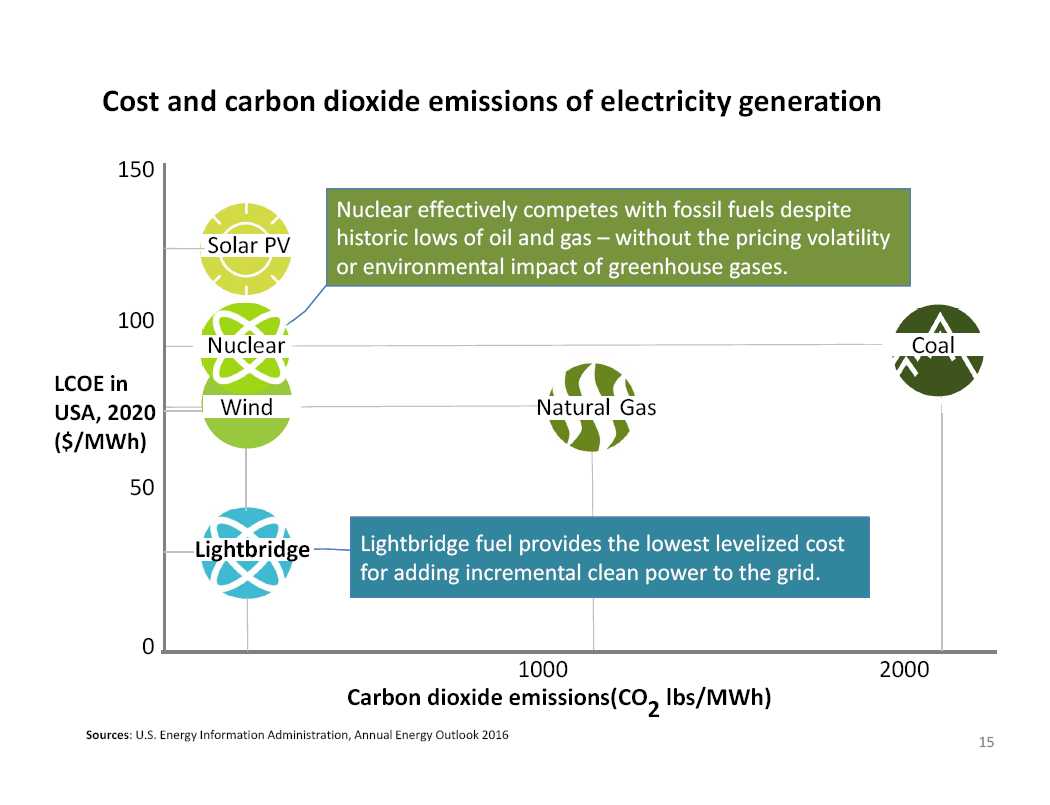


U.S. Clean Power Plan (CPP)
“The [US Environmental Protection Agency] EPA expects nuclear power to be a key partner in achieving the goals of the CPP. States can use new nuclear generation to help meet their Clean Power Plan goals. This includes new nuclear reactors that come on-line, including those under construction, and existing facilities that expand their capacity (uprates) .”
“Nuclear, like renewable energy generation and energy efficiency programs, can compete well and play an important role in complying with rate-based plans through the creation of emission rate credits (ERCs) from new and uprated nuclear capacity. If a state chooses to meet a rate-based goal and allows the use of ERCs, then new and uprated nuclear capacity may be eligible to receive ERCs based on zero-emitting MWh of generation. Since an ERC is a tradable compliance instrument, it represents an asset that can be sold in the market, resulting in a monetary payment to nuclear power plant owners .”- Source: EPA
| • | Lightbridge fuel can add meaningful amounts of new nuclear power without adding new reactors |
| • | Economic benefits of Lightbridge’s metallic fuel are consistent with the CPP goals: |
| o | Power uprates to existing nuclear plants | |
| o | Lengthening the fuel cycle at existing plants | |
| o | ERCs from increased electricity generation |
18
Lightbridge technology facilitates a high return for utilities
Internal rate of return (IRR) for a US nuclear power plant, after incremental nuclear fuel cost and Lightbridge royalties:

| 1Source: Siemens Industry Inc. Levelized Cost Model, December 2012 |
| 19 |
| Initial Target Market: |
 |
| Operating pressurized water | |
| reactors of >900 MWe with | |
| >20 years licensed life at 2025 | |
| We are initially focusing on US | |
| Nuclear Regulatory Commission (NRC) | |
| approvals and deployment in large | |
| reactors in the US. NRC licensing will | |
| facilitate approvals in other countries. | |
| Lightbridge fuel can be used in almost | |
| every reactor in the world and almost | |
| every reactor under construction or | |
| planned. In addition to pressurized | |
| water reactors, Lightbridge fuel is also | |
| applicable to boiling water reactors, | |
| light-water based small modular | |
| reactors, and heavy water reactors. |
| Sources: | IAEA Power Reactor Information System, June 2016 | |
| U.S. Energy Information Administration, International Energy Outlook 2016 | 20 |
Annual royalty revenue projections for 10% power uprate fuel

Notes:
1. Annual royalty revenue includes an escalation factor of 3%
per year to 2030
2. Wholesale electricity price of $55/MWh
21
Nuclear Fuel Utility Advisory Board
Formed in 2011 and expanded in 2012, the Nuclear Utility Fuel Advisory Board (NUFAB) is comprised of senior fuel managers from electric utility companies that account for approximately 50% of installed US nuclear capacity. NUFAB members represent the "voice of the customer" in Lightbridge’s nuclear fuel development and commercialization activities.
In 2015, utilities representing 50% of the U.S. nuclear market requested the Nuclear Regulatory Commission (NRC) to prepare to review Lightbridge’s patented fuel design in advance of an expected application in 2017 to use Lightbridge’s fuel in a US commercial reactor.
The letter serves as advance notice to the NRC to begin preparing for license applications, to be submitted in 2017, for first use in US pressurized water reactors as early as 2020. The letter these utilities wrote to the NRC demonstrates strong interest in the fuel, which has helped drive interest from fuel fabricating companies.

Lightbridge technology has been independently validated by respected industry organizations
 |
Siemens Global Study Validates Economic Benefits of Lightbridge Metallic Fuel |
| Siemens Study Validates Non-Proliferation Benefits of Lightbridge Fuel | |
| American Nuclear Society’s Nuclear Technology Peer-Reviewed Article |
| • | Technology value proposition | |
| • | Metallic fuel can be fabricated and used in commercial | |
| These studies confirm Lightbridge’s: | reactors utilizing existing industry supply chains | |
| • | Non-proliferation properties |

Lightbridge completed initial manufacturing and testing of its fuel in Russia, leading to planned testing under commercial reactor conditions in Norway in 2017
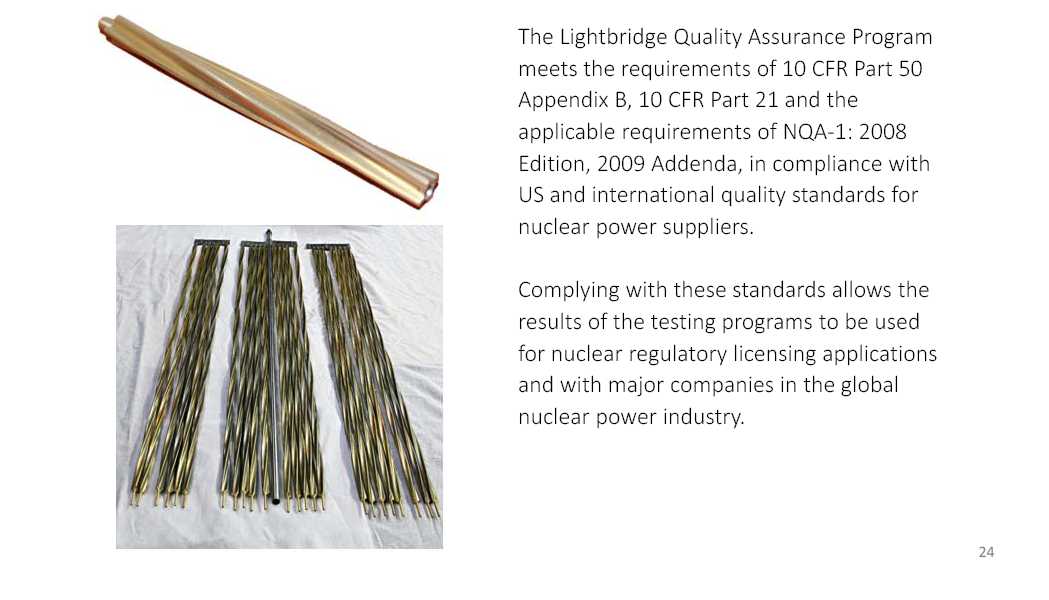
Manufacturing Lightbridge fuel
Fuel manufacturers are attracted to Lightbridge fuel as it is a non-disruptor, working within the existing industry and regulatory framework.
Lightbridge intends to enter into commercial arrangements with multiple fuel fabricating companies with limited exclusivity. Working with multiple fabricators will create competition, helping to enable Lightbridge to negotiate favorable commercial terms.
| • | In September 2015, Lightbridge signed a Comprehensive Nuclear Services Agreement with Canadian Nuclear Laboratories (CNL) for fabrication of Lightbridge’s patented next generation metallic nuclear fuel test samples at CNL facilities at Chalk River, Ontario, Canada. |
 |
| • | In January 2016, Lightbridge entered into an Initial Services Agreement with BWXT Nuclear Energy, Inc., a wholly owned subsidiary of BWX Technologies, Inc. (NYSE:BWXT), to prepare a preliminary plan for fabrication of Lightbridge-designed partial length nuclear fuel samples at BWXT facilities in the United States. |
 |
| • | Lightbridge is in discussions with additional nuclear fuel fabricating companies. |
25
Key milestones - completed
Significant progress with modest investment since announcing the concept of metallic fuel for power uprates in 2010:
| √ | Initial design and testing of metallic fuel. |
| √ | Manufacture and test prototypes in Russia. |
| √ | Independent validation. |
| √ | Main US patent issued in 2014; patents granted in Canada, China, European Union member countries, Japan, Russia, and other major international markets, and additional patents are pending. |
| √ | Written expression of interest from four major US utilities to Nuclear Regulatory Commission (NRC) in 2015 requesting that the NRC prepare to receive a license application in 2017. |
| √ | Contracts with Canadian Nuclear Laboratories and BWXT Nuclear Energy to prepare a plan for manufacturing fuel samples for testing under commercial reactor conditions. |
| √ | Granted regulatory approval from Norwegian Radiation Protection Authority for all planned irradiation of Lightbridge metallic fuel at the Halden Research Reactor in Norway. |
| √ | Contract with Institute for Energy Technology (IFE) in Norway for demonstration of the Lightbridge fuel in Halden reactor under commercial reactor operating conditions and post- irradiation examination at Studsvik in Sweden. |
26

Highlights of Lightbridge Corporation
| √ | Developed and commercializing next generation nuclear fuel technology to meet energy and climate needs |
| o | Introduced new fuel design in 2010 with over $24M investment to date | |
| o | Patented and independently validated metallic nuclear fuel | |
| o | Completed initial manufacturing and successful testing of the fuel | |
| o | World class development team & partners including Canadian Nuclear Laboratories (CNL), BXT Technologies (BWXT), and Institute for Energy Technology (IFE) |
| √ | Improves the operating economics and safety of existing and new reactors |
| o | Increased power output and enhanced reactor safety | |
| o | Added revenue and high IRR for operators of existing and new reactors | |
| o | Support from leading US utilities including Exelon, Duke, Dominion & Southern |
| √ | Addresses growing $25 billion global market for nuclear fuel |
| o | Represents the lowest levelized cost for adding incremental power to the grid |
| √ | High-margin revenue model from licensing & royalty fees |
| o | 25% penetration of US alone would generate $150-200M of royalty fees per year |
| √ | Clean capital structure with no debt |
28
Corporate Governance

29

Data Sources
| Slide 7, Increasing world energy needs | |
| http://www.census.gov/population/international/data/idb/worldpopgraph.php | |
| http://www.eia.gov/forecasts/ieo/pdf/0484(2016).pdf | |
| http://cmo-ripu.blogspot.com/2016/03/update-january-2016.html | |
| Slide 8, Energy equivalent of one cubic mile of oil | |
| http://cmo-ripu.blogspot.com/2015/02/getting-real-about-energy-in-cubic.html | |
| Slide 9, Nuclear power R&D programs in the USA | |
| http://www.thirdway.org/report/the-advanced-nuclear-industry | |
| Slide 15, Cost and carbon dioxide emissions of electricity generation | |
| http://www.eia.gov/forecasts/aeo/electricity_generation.cfm | |
| https://www.eia.gov/tools/faqs/faq.cfm?id=74&t=11 | |
| Slide 19, Lightbridge technology facilitates a high return for utilities | |
| http://ltbridge.com/assets/28.pdf | |
| Slide 20, Initial Target Market | |
| https://www.iaea.org/PRIS/WorldStatistics/UnderConstructionReactorsByCountry.aspx | |
| http://www.eia.gov/forecasts/ieo/pdf/0484(2016).pdf | |
31
